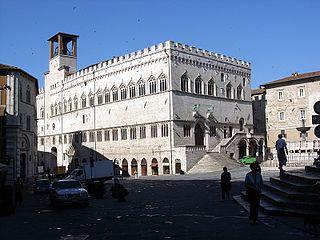
The Palazzo dei Priori or comunale is one of the best examples in Italy of a public palace from the communal era. It is located in the central Piazza IV Novembre in Perugia, Umbria. It extends along Corso Vannucci up to Via Boncambi. It still houses part of the municipality, and, on the third floor, the Galleria Nazionale dell'Umbria. It takes its name from the Priori, the highest political authority governing the city in the medieval era.
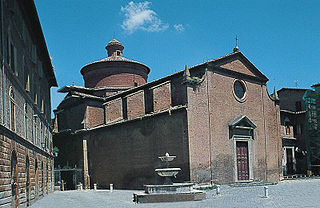
Santo Spirito is a Renaissance style, Roman Catholic church located in piazza Santo Spirito, where Via dei Pispini meets Vicolo del Sasso, in Siena, Italy.

San Raimondo, also called San Raimondo al Refugio, is a Baroque style, Roman Catholic church located on the intersection of Via del Refugio and Via di Fiera Vecchia, in the Terzo of Camollia of the city of Siena, region of Tuscany, Italy. The church is dedicated to St Raymond of Pennafort.

Piazza della Cisterna is a piazza in San Gimignano, Italy. It has a triangular shape with a slight natural slope and is connected to the nearby Piazza del Duomo by an open passage. The pavement is brick and the piazza is surrounded by houses and medieval towers.
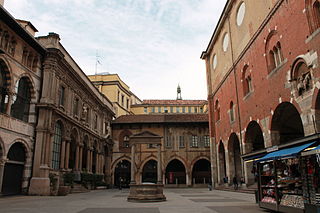
Piazza Mercanti is a central city square of Milan, Italy. It is located between Piazza del Duomo, which marks the centre of the modern city of Milan, and Piazza Cordusio, and it used to be the heart of the city in the Middle Ages. At the time, the square was larger than it is now and known as "Piazza del Broletto", after the "Broletto Nuovo", the palace that occupied the centre of the square. In the 13th century, there were six entry points to the square, each associated to a specific trade, from sword blacksmiths to hat makers.

Piazza d'Aracoeli is a square of Rome (Italy), placed at the base of the Capitoline Hill, in the Rione X Campitelli.

San Giovannino della Staffa, also known as San Giovannino in Pantaneto is a Renaissance style, Roman Catholic church located on Piazetta Virgilio Grassi, in the Contrada del Leocorno, in the city of Siena, region of Tuscany, Italy.

The Palazzo Piccolomini, also known as the Palazzo Todeschini Piccolomini is a Renaissance-style palace in the city of Siena, region of Tuscany, Italy. It is located on the Banchi di Sotto, at the corner with Via Rinaldini; uphill and west of the church of San Martino, the Loggia del Papa, and the Palazzo delle Papesse, which also built by a Piccolomini family member.

The Palazzo Palmieri, or Palazzo Nuti, is a Mannerist style urban palace, located on Via del Moro #48 in the present contrada of Civetta, Terzo di Camollia of the city of Siena, region of Tuscany, Italy.

The Palazzo Bindi Sergardi, previously Agostini and later Casini-Casuccini is, from the outside, a non-descript urban building located on Via dei Pellegrini # 18 in central Siena, region of Tuscany, Italy. The site is best known for containing frescoes by the late-Renaissance painter Domenico Beccafumi and Cristoforo Roncalli.

Santi Quirico e Giulitta, also called San Quirico in Castelvecchio is a Renaissance style, Roman Catholic parish church located in Pian de Mantellini in the Terzo de Citta of Siena, region of Tuscany, Italy.

San Niccolò al Carmine, also called Santa Maria del Carmine is a Renaissance style, Roman Catholic church and monastery located in Pian dei Mantellini #30, near the corner of Via della Diana in the Terzo de Citta of Siena, region of Tuscany, Italy. The church now serves as the Oratory for the Contrada of Pantera. Across the street from the belltower is the Palazzo Celsi Pollini. North along Pian dei Mantellini, toward the Arco delle Due Porte, and on the same side of the street are a number of palaces built around what was once the Monastery of the Derelict Women: in order they are the Neoclassical Palazzo Incontri, the Palazzo Ravissa and the Palazzo Segardi.
The Castello di Belcaro is a Renaissance villa built at the site of a Castle once belonging to the Republic of Siena in Tuscany. It is located some 5.5 kilometers southwest of the Siena city gate of Porta San Marco, on the direction towards Grosseto, it is beyond a former benedictine monastery and church of Sant'Eugenio. The address is strada di Terrenzano e Belcaro #32.
The Arco delle Due Porte or Arch of Two Doors is one of the remaining portals in the 11th century walls of Siena. It has been variously called the Porta di Stalloreggi with the gates known as San Quirico, Santa Margherita, and the Arco di Santa Lucia. It was the entrance into the southwesternmost end of Via Stalloreggi in Siena, region of Tuscany, Italy. Outside of the portal, in the Piazetta dell Due Porte are a confluence of streets: Via Fosso di Sant'Ansano flows south, Via Paolo Mascagni flows west, and Pian dei Mantellini flows south. Via Mascagni leads down the slope some 200 meters to the 13th-century gate: Porta Laterina. Pian dei Mantellini lead to the church and convent del Carmine.
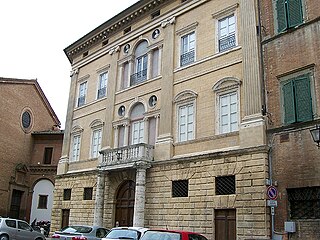
The Palazzo Incontri is a Neoclassical style urban palace locate on Pian dei Mantellini in Terzo di Citta of Siena, region of Tuscany, Italy. The palace rises between the church and convent of San Niccolò al Carmine and what was formerly the Convento delle Derelitti. Across the street is the Palazzo Celsi Pollini, Siena.
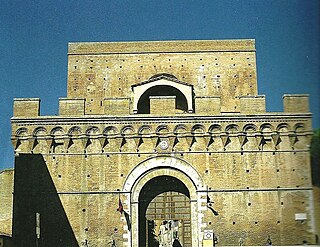
The Porta dei Pìspini or Gate of the Water-spout is one of the portals in the medieval walls of Siena, region of Tuscany, Italy. It is located on the east side of town, in the contrada del Nicchio in the terzo of San Martino, where Via Pìspini meets Via Aretina. The gate took its name from a nearby fountain; the nearby Fonte de' Pispina, however, was built in 1534–1538.

The Palazzo Fineschi Sergardi is a 16th-century urban palace located the Pian dei Mantellini neighborhood of the city of Siena, region of Tuscany, Italy. It is located near the Palazzo Celsi Pollini.

San Giacinto is a Renaissance-style, former-Roman Catholic church, now deconsecrated, located at via dei Pispini 162a, in the city of Siena, region of Tuscany, Italy. It is located about 8 doors down from Porta dei Pìspini on the south side of the street.
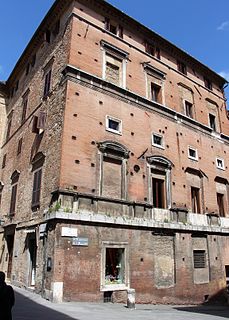
The Palazzo Francesconi, later Mocenni, is a 16th-century Renaissance urban palace located on Via del Cavallerizzo in the city of Siena, region of Tuscany, Italy.
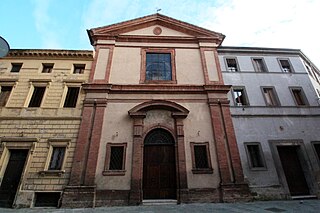
Santi Niccolò e Lucia, also known only as Santa Lucia, is a Roman Catholic church located in Pian dei Mantellini, in the city of Siena, region of Tuscany, Italy.


















